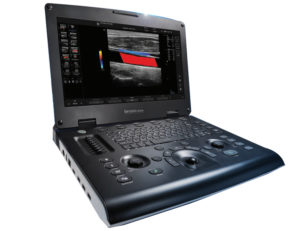Different mobile equipment allows us to carry out specialized procedures with referring veterinarians who request them. The description of these procedures (ultrasounds, endoscopies, bone marrow biopsies, etc.) is available by clicking on the buttons below. All of our prices are available on request by email or via the contact form
Our latest generation ultrasound system from General Electric with its 3 probes allows us to perform abdominal, thoracic and superficial ultrasounds. Since it is portable, we can easily go to veterinary private practices to perform these acts.

Most ultrasounds are done without anesthesia, or possibly with light sedation, but require shaving. Animals should also be fasting for abdominal ultrasounds. Ultrasound can be used to locate a lesion more precisely, to define its contours, relationships and vascularization. It never establish a definite diagnosis, but makes it possible to visualize the site which need to be sampled in order to differentiate the inflammatory, infectious or neoplastic processes. Some of these samples can be taken minimally invasively with ultrasound guidance: pleural, abdominal and pericardial fluids, sterile urine or bile sampling, fine needle aspiration of liver, spleen, mass… It also allows to assess the size, viability and sometimes the number of fetuses during gestation.3

A complete Storz equipment (videoendoscopy, fibroscopy, rigid endoscopy) allows us to perform rhinoscopy, bronchoscopy, laryngoscopy, esophagoscopy, gastroduodenoscopy, colonoscopy and cystoscopy (only in females for the latter).
Endoscopy is a moderately invasive technique of internal exploration, which is performed under general anesthesia, for the safety and comfort of the animals. The objectives of an endoscopy can be diagnostic or therapeutic.
An endoscopy for diagnostic purposes is generally decided after performing medical imaging procedures (x-rays, ultrasound, CT-scan), which make it possible to locate the sites and organs to be explored. As ultrasound, endoscopy on its own can never establish a definite diagnosis, but it is used to take samples. These samples can be biopsies for histopathological examination, or samples for cytological examinations or bacteriological purposes (cytobrush, bronchoalveolar lavage, etc.). These samples generally identify the type of lesion which is interpreted with the help of a careful study of the history and clinical examination. This is why a specialized consultation is most of the time necessary before an endoscopy for diagnostic purposes, in order to establish a definite diagnosis, and therefore to offer the most appropriate therapeutic management in the clinical context.
Therapeutic endoscopy may be necessary for minimally invasive extraction of digestive, nasal, bronchial or urethral foreign bodies. It can also be used to dilate strictures, mainly esophageal.
In internal medicine and oncology, the following procedures may be necessary in patient care:
